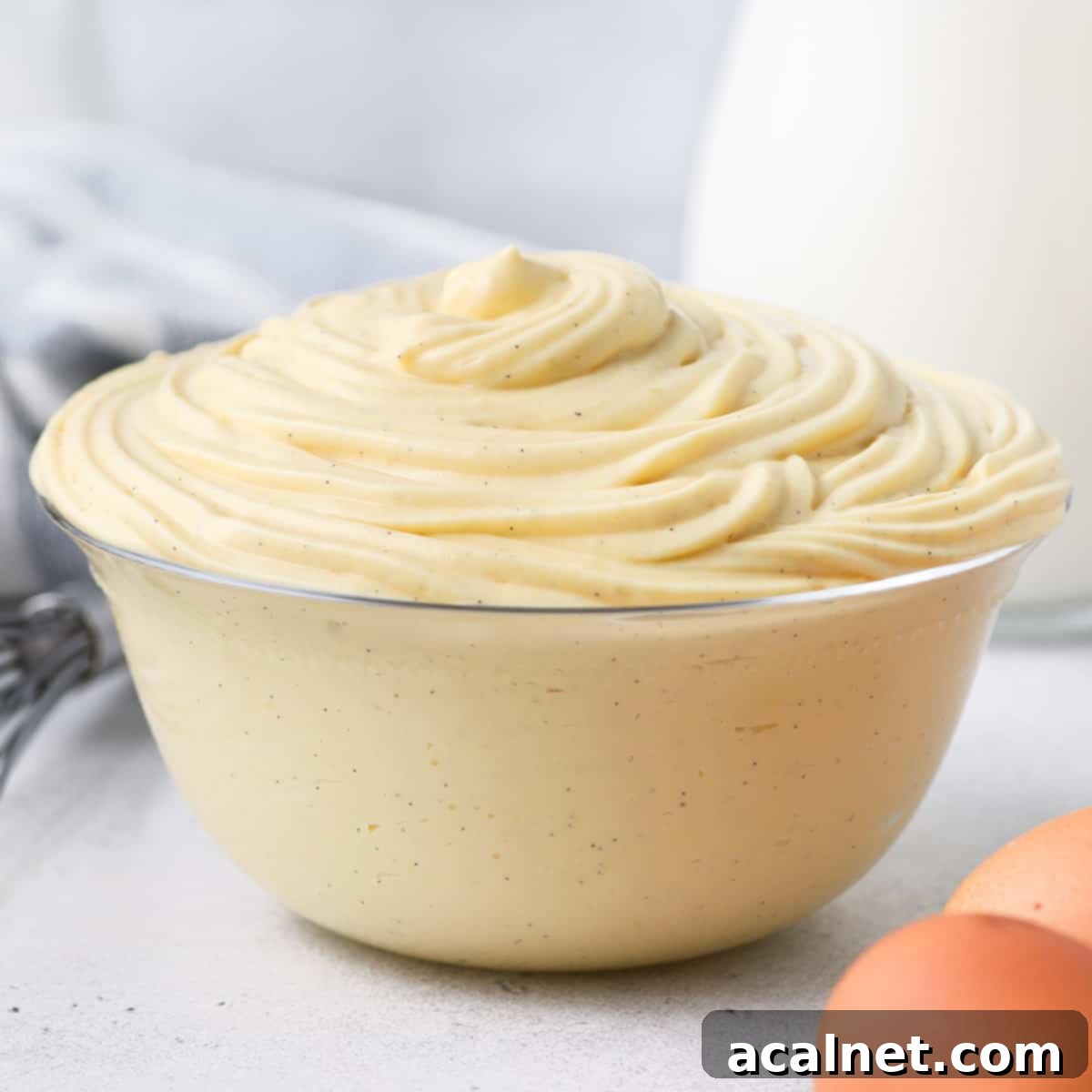Mastering Crème Diplomate: Your Ultimate Guide to Light, Stable French Diplomat Cream
The exquisite Diplomat Cream, known in French as Crème Diplomate, stands as a true classic in the realm of French pastry. It’s a sublime fusion of rich Pastry Cream, delicately stabilized with gelatine, and lightened with airy Whipped Cream. The result is a dessert masterpiece: a super creamy, indulgent yet remarkably light and ethereal cream that elevates any sweet creation. Whether used as a luscious filling or an elegant topping, Diplomat Cream promises an unparalleled texture and flavor experience for your most delicious desserts and pastries.

Why You’ll Adore This Diplomat Cream Recipe
Diplomat Cream, affectionately known as Crème Diplomate, holds a special place in the hearts of pastry enthusiasts, and for good reason. It skillfully marries the deeply satisfying, rich flavors of traditional Pastry Cream with the delicate lightness and airy texture of freshly whipped cream. Think of it as an elevated Crème Légère or even a Bavarian Cream, but with a unique twist that makes it truly exceptional.
What truly sets Diplomat Cream apart is the thoughtful addition of a small amount of gelatine. This secret ingredient transforms it into a remarkably stable cream, allowing it to hold its shape beautifully whether you’re piping intricate designs, layering it as a cake filling, or creating stunning dessert presentations. This stability, combined with its irresistible taste and texture, makes it an incredibly versatile component in your baking repertoire.
Imagine filling delicate Choux à la Crème with its silky embrace, using it as the luscious core of a classic Fraisier Cake, or creating an unforgettable base for a fresh fruit tart. It’s equally at home nestled inside elaborate cakes and entremets, proving itself as a consistently delicious and reliable addition to any sweet creation you dream up.
Understanding Diplomat Cream: A French Pastry Essential
At its core, a Crème Diplomate is a fundamental French pastry cream that expertly blends three key elements: classic Pastry Cream (Crème Pâtissière), light and airy Whipped Cream, and a touch of Gelatine for enhanced stability. While it shares similarities with Crème Légère (which is simply pastry cream folded with whipped cream), Diplomat Cream distinguishes itself by the inclusion of gelatine, making it more robust and capable of holding its form, particularly when piped or used in structured desserts. This added stability is crucial for professional-looking finishes and ensures your desserts maintain their integrity.
The versatility of this cream is truly remarkable. It can be used in a vast array of pastries and desserts, adapting beautifully to various applications. Furthermore, its neutral base makes it an ideal canvas for a multitude of flavors. You can infuse it with rich chocolate, aromatic coffee, vibrant fruit purees, zesty citrus, or even a hint of sophisticated alcohol, allowing you to customize it to perfectly complement any dessert concept.
Essential Ingredients for Perfect Diplomat Cream

Crafting this delightful cream requires just a few basic, high-quality ingredients – essentially those needed for a classic pastry cream, plus the crucial additions of heavy cream and gelatine. Here’s a closer look at what you’ll need to make a truly exceptional Diplomat Cream (refer to the recipe card below for precise quantities):
- Milk: For the richest flavor and best texture, always opt for Full Cream Milk (Whole Milk). While plant-based milks can be used to make pastry cream, be mindful that many dairy-free alternatives are flavored (e.g., coconut, almond), which will subtly alter the final taste of your Diplomat Cream. Choose an unflavored variety for a more neutral base.
- Vanilla: The gold standard is always fresh Vanilla Beans for their deep, complex aroma. If fresh beans are not accessible or too expensive, high-quality Vanilla Paste is an excellent second choice. Vanilla Extract or Essence can be used as a last resort, but be aware that you will lose some of the vibrant, authentic vanilla flavor.
- Eggs: This recipe specifically calls for Egg Yolks only. For optimal emulsification and a smoother cream, it’s preferable to use them at room temperature. Don’t discard those leftover egg whites! They can be used to make other wonderful treats like Financiers or meringues.
- Sugar: Fine Caster Sugar or a finely granulated white sugar is ideal for dissolving smoothly into the mixture. This recipe provides a balanced sweetness, but if you prefer a sweeter cream, feel free to slightly increase the sugar content to your taste.
- Cornstarch: This is your primary thickening agent for the Crème Pâtissière. While all-purpose flour or other starches like potato starch or arrowroot can be substituted, cornstarch consistently yields the lightest, smoothest, and most lump-free texture for the pastry cream component, which is essential for a silky Diplomat Cream.
- Gelatine: I typically use Gelatine Powder, which needs to be bloomed in a small amount of very cold water before use. Alternatively, you can use Gelatine Leaves. The quantity of gelatine is adaptable; you can slightly increase or decrease it based on how firm and stable you want your Diplomat Cream to be – more for piping, less for a softer filling.
- Cream: Heavy Cream or Thickened Cream is essential here. It must contain at least 30% fat to whip properly and achieve those crucial stiff peaks. Avoid light or reduced-fat creams, as they will not whip effectively. Dairy-free cream alternatives can also be used, provided they have a sufficiently high fat content to be whipped.
Some traditional pastry cream recipes incorporate butter for added richness, but for a truly light and airy Diplomat Cream, I find it unnecessary and prefer to omit it to maintain that desirable delicate texture.
Exquisite Flavour Variations
While classic Diplomat Cream shines with elegant vanilla, its neutral base makes it incredibly adaptable to a world of flavors. Don’t hesitate to get creative!
- For a deeply indulgent treat, transform it into a Chocolate Diplomat Cream by replacing the vanilla pastry cream with a rich Chocolate Pastry Cream.
- Infuse the milk with robust coffee grounds to create a Coffee Diplomat Cream, perfect for Coffee Choux Buns or tiramisu-inspired desserts.
- Introduce vibrant fruit flavors by replacing some of the milk with a fruit puree, such as berries (raspberry, strawberry), or a tangy citrus juice like orange or lemon.
- Explore exotic notes by adding a hint of Matcha powder for a delicate green tea flavor, or a few drops of aromatic Orange Blossom Water for a floral touch.
- For a nutty indulgence, stir in some Hazelnut Praline Paste or finely ground pistachios to the pastry cream for a rich, textured variation.
- A splash of your favorite liqueur, such as Grand Marnier, Kirsch, or rum, can also add a sophisticated depth of flavor.
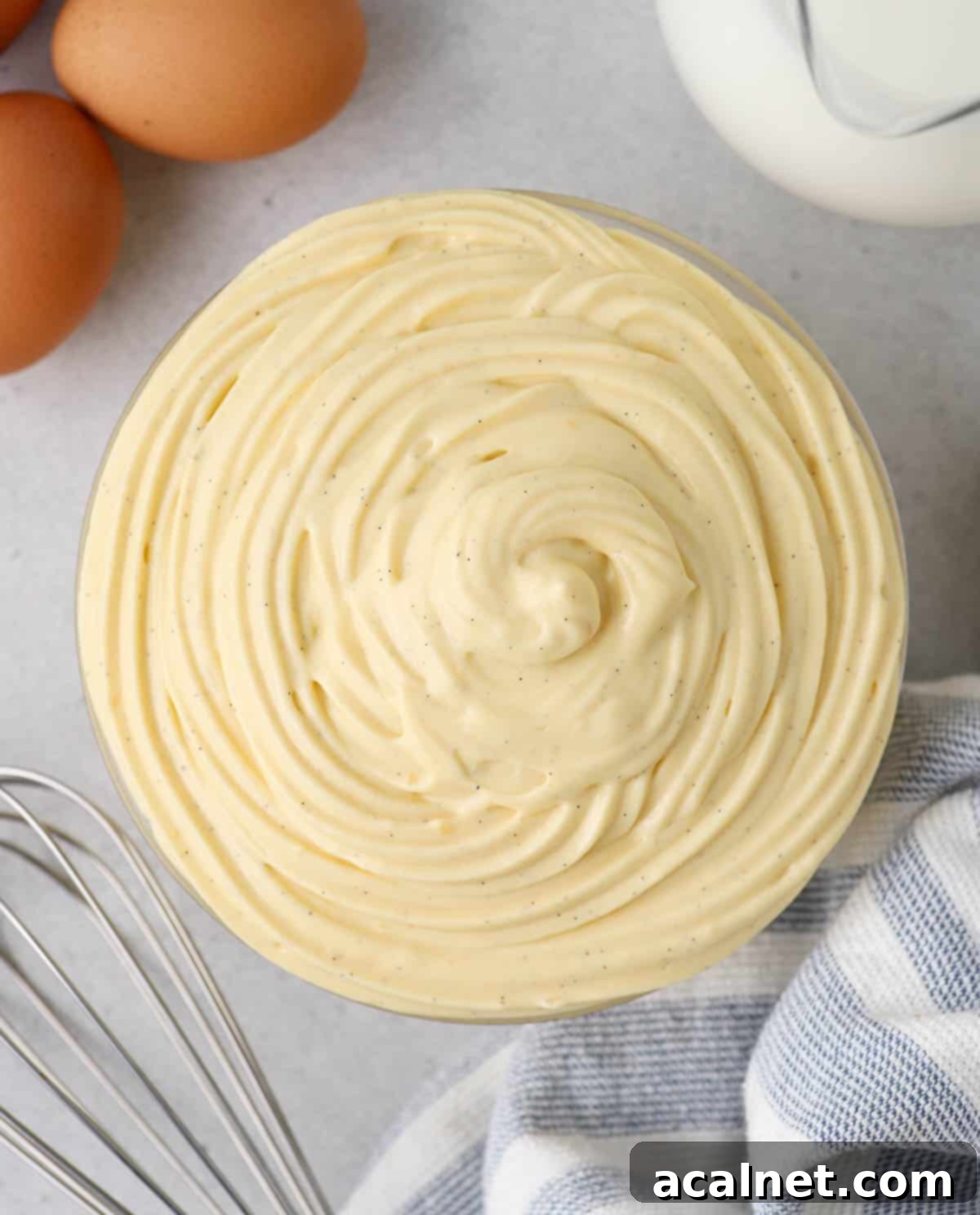
Step-by-Step: Crafting French Diplomat Cream
The process of making French Diplomat Cream involves two main stages: first, preparing the stabilized pastry cream, and then gently folding in the whipped cream. The pastry cream component needs to be made ahead of time to allow it to cool properly before combining with the delicate whipped cream.
- Photo 1: Prepare the Milk Infusion
Combine the Milk and Vanilla Paste (or vanilla bean and seeds if using fresh) in a saucepan. Whisk them together thoroughly and heat over low heat until the mixture just begins to simmer. If you’re using fresh vanilla bean, split it lengthwise, scrape out the seeds, and add both the pod and seeds to the milk. Heat, then remove from heat, cover, and let infuse for about 20 minutes to extract maximum flavor. Remember to remove the vanilla pods before proceeding. - Photo 2: Whisk Egg Yolks and Sugar
While your milk is warming, place the Egg Yolks and Sugar in a heat-proof mixing bowl. Whisk them vigorously until the mixture is pale yellow and slightly thickened. This process helps to dissolve the sugar and prepares the yolks. - Photo 3: Incorporate Cornstarch
Add the Cornstarch to the egg yolk and sugar mixture. Continue whisking until the mixture is completely smooth and free of any lumps. The cornstarch acts as a crucial thickening agent for your pastry cream. - Photo 4: Temper the Egg Yolks
Gradually and slowly pour a portion of the hot milk into the egg yolk and sugar mixture while continuously whisking. This critical step, known as tempering, slowly raises the temperature of the egg yolks, preventing them from scrambling when they are returned to the hot saucepan. Once tempered, pour the entire mixture back into the saucepan with the remaining hot milk.
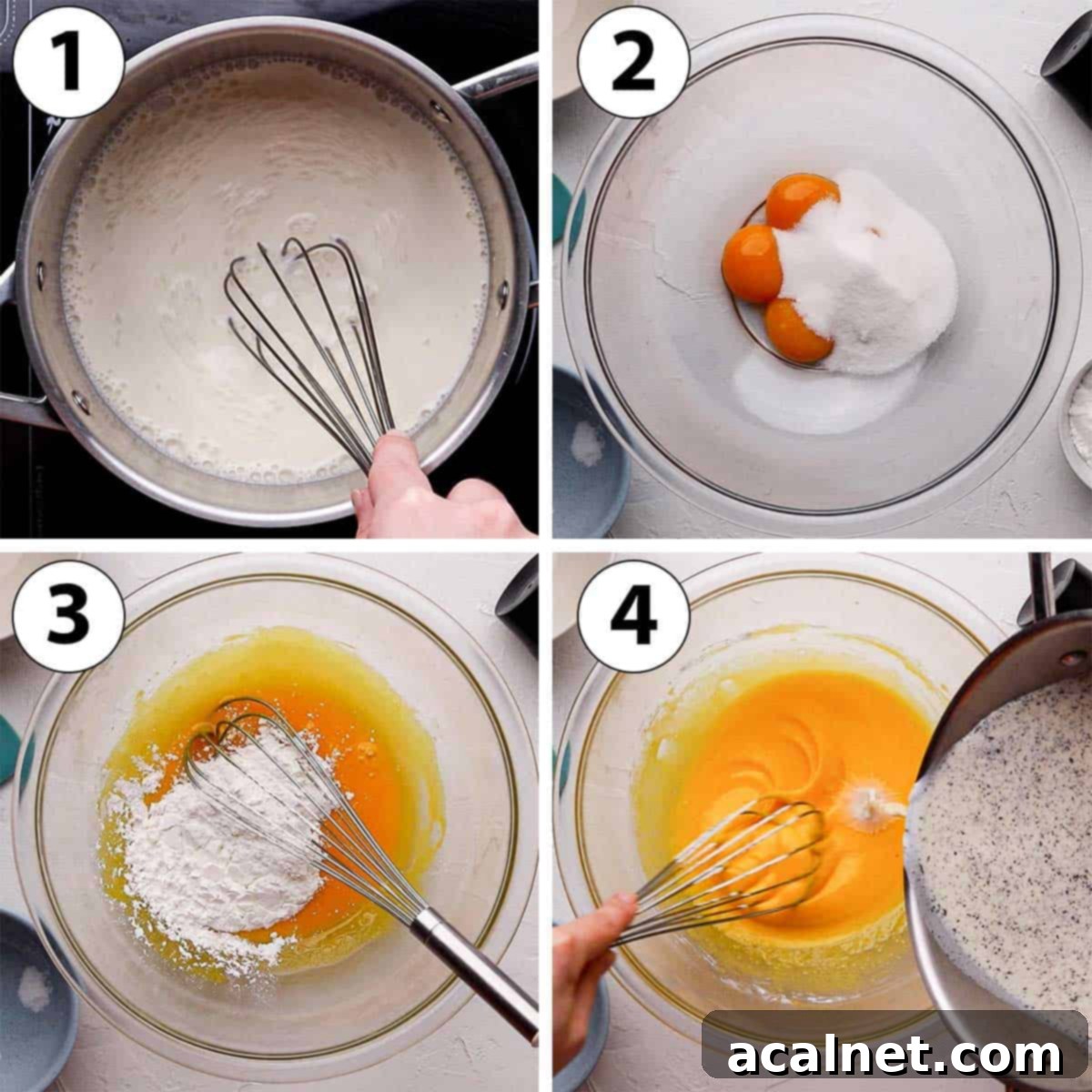
- Photo 5: Cook the Pastry Cream
Return the saucepan to the stove over low to medium heat. Whisk continuously and diligently until the custard visibly thickens. Once it begins to boil, continue whisking for another 30 seconds to a minute to ensure the cornstarch is fully cooked and activated, preventing a starchy taste. Then, remove the saucepan from the heat immediately. - Prepare the Gelatine
If using Gelatine Powder, place it in a small bowl and mix in a small amount of very cold water (always refer to your gelatine package for the precise recommended water quantity, as brands vary). Let it sit for a few minutes to bloom, forming a thick, jelly-like paste. If you’re using Gelatine Leaves, submerge them in very cold water for about 10 minutes until softened, then squeeze out as much excess water as possible. - Photo 6: Incorporate Gelatine into Pastry Cream
Add the bloomed gelatine directly to the warm pastry cream (it will melt easily into the warm base). Whisk thoroughly until the gelatine is completely dissolved and fully incorporated into the cream. - Cool the Pastry Cream
Transfer the stabilized pastry cream into a large, shallow pan (like a baking dish or brownie pan). This wider surface area allows the custard to cool down much more quickly and evenly than in a deep bowl. Crucially, cover the surface of the cream directly with plastic wrap to prevent a skin from forming. Place it in the fridge to cool down until it’s cool to the touch but not fully set. Avoid chilling for too long, as the gelatine will start to firm up too much, making it difficult to combine with the whipped cream. It should be cool enough not to melt the whipped cream when added. - Photo 7: Whip the Heavy Cream
Once the pastry cream is sufficiently cooled, pour the very cold Heavy or Thickened Cream into a large mixing bowl (or the bowl of your stand mixer fitted with a whisk attachment). Whip on medium to high speed until it forms stiff peaks. Be careful not to over-whip, as this can cause the cream to become grainy or separate. - Photo 8: Fold in the Whipped Cream
Retrieve the cooled pastry cream from the fridge. If it has stiffened slightly, gently loosen it with a whisk until smooth. Then, using a spatula, gently fold the whipped cream into the pastry cream in 3 or 4 gradual additions. This gentle folding technique is essential to maintain the airy volume of the whipped cream, ensuring your Diplomat Cream remains light and fluffy. Continue folding until the mixture is homogeneous and beautifully smooth. - Serve or Store
Your decadent Diplomat Cream is now ready to use! Enjoy it immediately as a filling or topping, or store it in the refrigerator. Ensure it’s covered with plastic wrap, directly touching the surface, to prevent any skin from forming and to maintain its freshness.

Common Questions About Diplomat Cream
Understanding the nuances between these French creams is key. Pastry Cream (Crème Pâtissière) is a thick, rich custard base, cooked with milk, egg yolks, sugar, and a thickening agent like flour or cornstarch. It’s the foundation for many desserts. Chantilly Cream (Crème Chantilly) is simply sweetened whipped cream, often flavored with vanilla. It’s light and airy but lacks the richness of pastry cream and any inherent stability. Diplomat Cream (Crème Diplomate) is a luxurious combination of both: it starts with pastry cream, which is then lightened by folding in whipped cream, and crucially, stabilized with gelatine. This gives it the best of both worlds – the lusciousness of pastry cream with the airiness of whipped cream, plus the structural integrity to hold its shape beautifully, making it distinct from a simple Chantilly Cream.
Technically, yes, but it won’t be a true Crème Diplomate. A cream that combines pastry cream and whipped cream without gelatine is actually known as Crème Légère (or sometimes Crème Princesse) in French pastry. While still delicious, Crème Légère is significantly less stable than Diplomat Cream and will not hold its shape as well, particularly when piped. It’s primarily used as a soft filling for cakes or pastries where structural integrity isn’t as critical. The beauty of Diplomat Cream lies in its customizable stability provided by the gelatine. You have the flexibility to adjust the amount of gelatine; a little less will yield a softer, more delicate cream, while a bit more will create a very stable cream perfect for piping intricate decorations or building multi-layered desserts.
Absolutely! This recipe can be adapted to be dairy-free by substituting both the milk and heavy cream with suitable plant-based alternatives. However, it’s important to be mindful of a few considerations. Many plant-based milks, such as coconut or almond milk, come with their own distinct flavors, which will inevitably influence the final taste of your Diplomat Cream. Opt for unflavored varieties if you wish to maintain a neutral base, or embrace the added flavor if it complements your dessert. When selecting a dairy-free cream, ensure it has a sufficiently high-fat content (typically at least 30%) to guarantee it can be whipped to stiff peaks, which is crucial for the cream’s texture and body.
The versatility of Crème Diplomate is truly astounding, making it a star player in countless dessert applications. It’s an ideal filling for delicate Choux pastries, light Chouquettes, or elegant eclairs. It creates a stunning base for fresh fruit tarts, providing a creamy counterpoint to vibrant berries or sliced stone fruits. It’s the traditional filling for my beloved Fraisier Cake, contributing both richness and stability. Beyond these, it’s perfect inside layered cakes, individual pastries, and sophisticated entremets. Consider it for trifles, as a component in a classic Mille-Feuille, or to fill a delightful Tropezienne Brioche Tart. Its ability to be both rich and light, yet stable, makes it an indispensable cream for any baker.

Common Diplomat Cream Troubleshooting Tips
Even experienced bakers can encounter minor hiccups. Here’s how to address common issues when making Diplomat Cream:
- The Pastry Cream is lumpy: Lumps usually form if the heat was too high during cooking, causing the egg yolks to cook too quickly, or if you didn’t whisk continuously or vigorously enough. To salvage it, you can carefully pour the warm cream through a fine-mesh sieve to catch larger lumps. For smaller lumps, an immersion blender can smooth it out quickly, but be cautious – blend only for a few seconds, as over-blending can break down the starch and make the pastry cream liquid. Prevention is key: maintain low heat and consistent whisking.
- The Pastry Cream is too liquid after chilling: This indicates that your pastry cream wasn’t cooked for a sufficient amount of time on the stove. The cornstarch needs adequate heat and time to fully activate and thicken the cream. Ensure you bring the pastry cream to a full boil, then continue cooking and whisking for at least 1 minute (or even up to 2 minutes) after it starts bubbling to guarantee proper thickening.
- The Pastry Cream is very hard after chilling: This typically happens if the custard was chilled for too long, allowing the gelatine to completely set and firm up. The pastry cream should be cool, but still somewhat pliable, when you’re ready to fold in the whipped cream. If it’s too firm, try loosening it by vigorously whisking it by hand or with a stand mixer on low speed. If it’s still too stiff, you can gently re-warm it in the microwave for very short bursts (5-10 seconds at a time), whisking between each, until it reaches a soft, pliable consistency. Be very careful not to overheat it.
- The Diplomat Cream is too liquid after mixing: Several factors can contribute to a runny Diplomat Cream. You might have used too little gelatine for the desired stability, or the heavy cream may not have been whipped to stiff enough peaks. Ensure your heavy cream is very cold and whipped until it forms firm, stable peaks before gently folding it into the cooled pastry cream. Also, ensure the pastry cream was cool enough before combining, as warm pastry cream will melt the whipped cream.

Essential Tips for a Flawless Diplomat Cream
Achieving a perfectly smooth, light, and stable Diplomat Cream is straightforward with these key tips:
- Adjust Gelatine for Desired Stability: The amount of gelatine is flexible and should be tailored to your intended use. The quantity in this recipe yields a relatively soft cream, ideal for filling delicate choux pastries. If you plan to use it as a robust cake filling, for intricate piping work, or as a structural element in an entremet, consider slightly increasing the gelatine content. This will ensure it sets more firmly and maintains its shape under different conditions.
- Control Creaminess with Whipped Cream Quantity: The ratio of whipped cream to pastry cream significantly impacts the final texture. For a richer, denser, and slightly firmer diplomat cream, use less whipped cream. If you prefer an exceptionally light, airy, and fluffy texture, incorporate a larger quantity of whipped cream. Experiment to find your perfect balance.
- Efficiently Cool the Pastry Cream: To expedite the cooling process and ensure even temperature distribution, always transfer your freshly cooked pastry cream into a large, shallow pan (like a baking sheet or brownie pan). This maximizes the surface area, allowing it to cool much faster than in a deep bowl. Crucially, cover the surface of the cream directly with plastic wrap. This step prevents the formation of an undesirable thick skin on top, preserving the smooth consistency.
- Chill for Optimal Stability: While Diplomat Cream can be used immediately for fillings like choux or eclairs, for applications requiring maximum stability – such as cake toppings, layered desserts, or intricate entremets – it’s highly recommended to chill the finished Diplomat Cream for a few hours (at least 2-4 hours) before use. This extended chilling time allows the gelatine to fully set, ensuring the cream is firm enough to be piped cleanly and hold its structure flawlessly.
Storing & Freezing Diplomat Cream
Proper storage is essential to maintain the freshness and delightful texture of your Diplomat Cream. Once prepared, it can be used immediately or stored in the refrigerator for up to 2 to 3 days. To prevent it from drying out or forming a skin, ensure it is covered tightly with plastic wrap, pressed directly against the surface of the cream.
Regarding freezing, while Diplomat Cream technically can be frozen, it’s generally not recommended. The delicate emulsion and texture of the cream, particularly due to the whipped cream component, can break down during the freezing and thawing process. This often results in a less desirable, sometimes watery or grainy, texture upon thawing, compromising the cream’s smooth and airy quality. For the best culinary experience, enjoy your Diplomat Cream fresh.
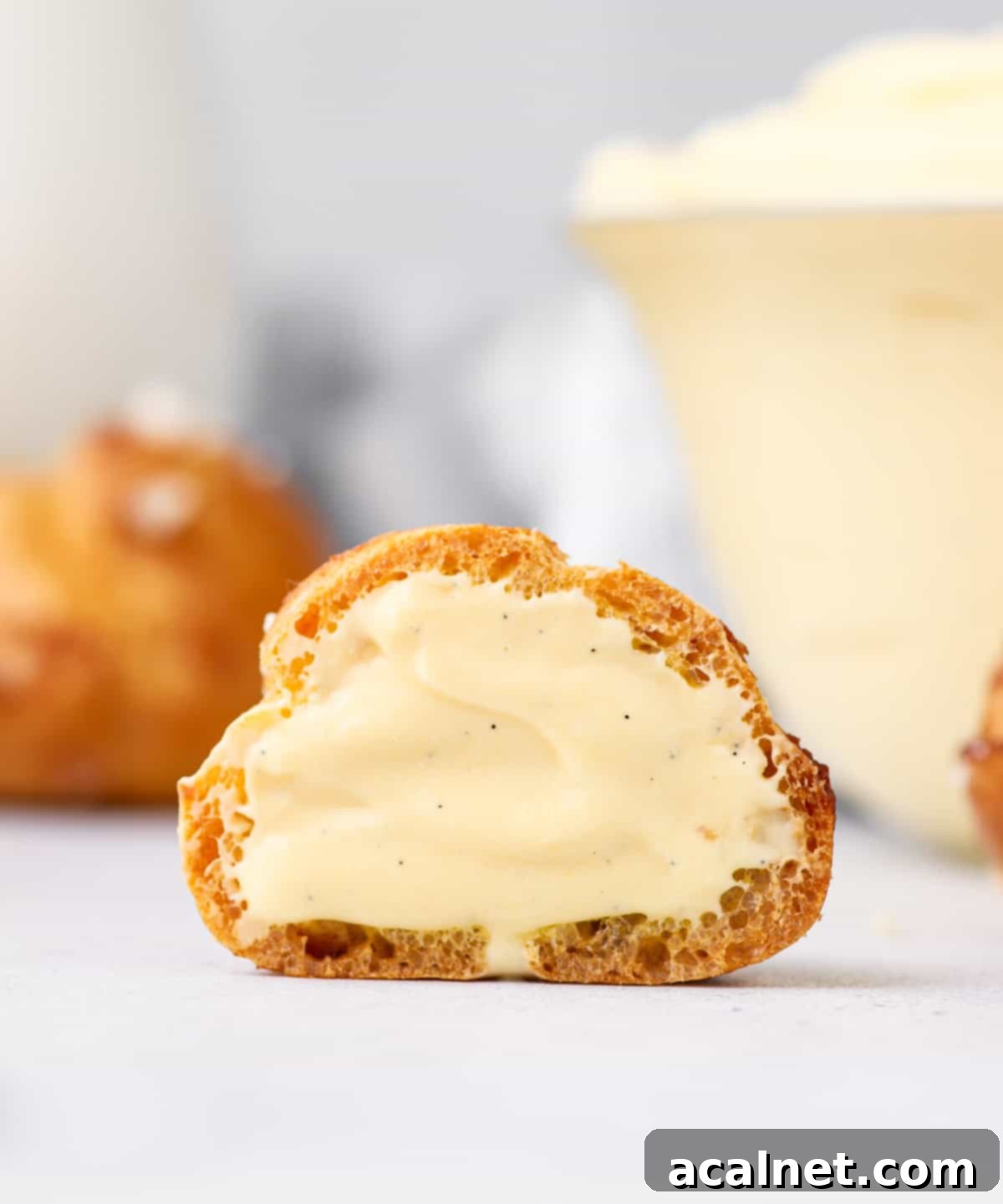
Explore More Irresistible Creams
If you’ve enjoyed mastering Diplomat Cream, broaden your pastry horizons with these other fantastic cream recipes:
- Almond Cream Filling (Frangipane)
- Whipped Ganache Frosting
- Pistachio Pastry Cream
- Chocolate Cremeux
- Namelaka
- Crème Anglaise
- Crème Chantilly
- Mousseline Cream
- Stabilised Mascarpone Whipped Cream
Made this recipe?
Let us know if you liked it by leaving a comment below, and tag us on Instagram @a.baking.journey with a photo of your creation!
Recipe Card: Diplomat Cream (Crème Diplomate)
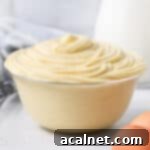
Diplomat Cream (Crème Diplomate)
Print Recipe
Ingredients
- 500 ml (2 cups) Full Cream Milk, (whole milk, for best flavor)
- 2 teaspoons Vanilla Paste, (or seeds from 2 fresh vanilla beans for superior flavor)
- 4 Large Egg Yolks, (preferably at room temperature)
- 60 gr (1/4 cup) Caster Sugar, (or fine white granulated sugar, adjust to taste)
- 30 gr (1/4 cup) Cornstarch, (essential for smooth thickening)
- 5 gr (1 1/2 teaspoons) Gelatine Powder, (plus cold water to bloom, see note 3 for details)
- 180 ml (3/4 cup) Cold Heavy Cream, (also known as Thickened Cream, must contain at least 30% fat)
Instructions
Part 1: Preparing the Pastry Cream Base
- In a saucepan, combine the Milk and Vanilla Paste. Whisk thoroughly and gently heat on low until it just begins to simmer. (If using fresh vanilla bean, infuse for 20 minutes off heat, then remove pods).
- While the milk heats, in a heat-proof bowl, vigorously whisk together the Egg Yolks and Caster Sugar until pale. Stir in the Cornstarch until the mixture is completely smooth.
- Slowly pour about a third of the hot milk into the egg yolk mixture, whisking constantly to temper the eggs. Then, pour the entire tempered mixture back into the saucepan with the remaining milk.
- Return the saucepan to low heat. Continuously whisk as the custard thickens (about 2-3 minutes). Once it starts to boil, continue whisking for another 30 seconds to 1 minute to ensure the cornstarch is fully cooked. Remove from heat.
- In a small bowl, bloom the Gelatine Powder by mixing it with a small amount of very cold water (refer to package directions). Let it sit for a few minutes until it forms a thick paste.
- Add the bloomed gelatine to the warm pastry cream and whisk thoroughly until it is completely dissolved. Transfer the pastry cream to a large, shallow pan, cover its surface directly with plastic wrap, and chill in the fridge for 1 to 1.5 hours, or until cool but not fully set.
Part 2: Assembling the Diplomat Cream
- In a large bowl (preferably chilled) or a stand mixer bowl, whip the very cold Heavy Cream on medium-high speed until it reaches stiff peaks. Be careful not to over-whip, which can make it grainy.
Part 3: Final Combination and Use
- Remove the cooled pastry cream from the fridge. If it has become too firm, gently whisk it to loosen. Then, in 3 or 4 gradual additions, gently fold the whipped cream into the pastry cream until fully combined. Be gentle to maintain the airy texture.
- Use your Diplomat Cream immediately as a filling for choux, eclairs, or tarts. For applications requiring more stability (like cake layers or piping), chill the finished cream for a few hours before using. Store any leftovers in the fridge, covered with plastic wrap directly touching the surface, for up to 2-3 days.
Video Tutorial
Would you like to save this recipe?
We’ll email this post to you, so you can come back to it later!
Notes
Ingredients Notes:
- Vanilla: If opting for Fresh Vanilla Beans, carefully split the bean lengthwise, scrape out the fragrant seeds, and add both the scraped bean and seeds to the milk. Heat as directed, then turn off the heat, cover the pot, and allow it to infuse for approximately 20 minutes before removing the spent pods. This extracts maximum flavor.
- Gelatine: Should you choose to use Gelatine Leaves instead of powder, you’ll typically need 1 1/2 sheets for this recipe. Submerge them in very cold water for several minutes until fully softened, then squeeze them thoroughly to remove as much excess water as possible before adding to the warm pastry cream. Remember, you can adjust the gelatine quantity (increase slightly for extra stability) if you plan on piping the cream or using it in a dessert that requires a very firm set.
- Heavy / Thickened Cream: It is crucial that your cream contains at least 30% fat content; anything less will not whip properly to the desired stiff peaks. You have the flexibility to adjust the amount of whipped cream you fold into the pastry cream. Use a lesser amount for a richer, denser filling, or incorporate more for a lighter, airier, and more ethereal cream texture.
Instruction Notes:
- This tempering step is vital. It gradually warms the egg yolks, preventing them from scrambling when they are cooked. Whisking continuously is key to a smooth consistency.
- The cooking time for pastry cream can vary based on your stove’s heat. Always use a very low to medium-low heat to avoid overcooking the eggs, which leads to lumps. While it may take a little longer to thicken, the resulting cream will be exceptionally smooth and silky. Ensure it comes to a boil and cooks for at least 1 minute afterward to fully activate the cornstarch.
- Different brands of gelatine powder may have slightly different hydration requirements. Always check the specific instructions on your gelatine package for the recommended amount of cold water needed to bloom it properly. As a general guide, about 2 tablespoons of very cold water is often sufficient for 5 grams of powder.
- Cooling the pastry cream in a broad, shallow pan (like a brownie pan or a sheet pan) greatly accelerates the cooling process and ensures it cools more uniformly, which is ideal for incorporating the whipped cream later.
- Do not over-chill the pastry cream once the gelatine has been added. It should be cool to the touch but still pliable enough to easily loosen with a whisk. If it becomes too firm, it will be challenging to fold into the whipped cream without losing the airy texture.
- When folding in the whipped cream, do so in several stages (3-4 times). This helps to gradually lighten the pastry cream and preserves the maximum amount of air in the whipped cream, resulting in a light and voluminous Diplomat Cream. It might feel a bit stiff to combine initially, but it will become easier as more whipped cream is added.
- For desserts where the cream needs to hold a very precise shape (e.g., piped decorations, cake layers, or entremets), allow the finished Diplomat Cream to chill for a minimum of 2-3 hours after assembly. This gives the gelatine ample time to set completely, ensuring a firm and stable structure. For less demanding applications like filling choux or eclairs, the cream can be used immediately after preparation.
Nutrition Information (per serving)
